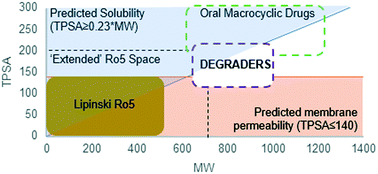Developing degraders: principles and perspectives on design and chemical space†
Abstract
Degraders (e.g. PROTACs, SNIPERs, degronimers etc.) are a new modality offering increasing potential both as tools for basic research and therapeutic development. They occupy chemical space that lies outside the classical Lipinski ‘Rule of 5’, which poses fresh challenges for achieving cell permeability and oral bioavailability. This study presents a comprehensive database of degrader structures from the peer reviewed literature, including both optimized degraders and first generation compounds, in order to provide a thorough assessment of the chemical space associated with this modality and identify common trends used during the ‘hit to lead’ process. The results provide insights into this new area of chemical space as well as pointers for degrader design, which we anticipate will be useful for researchers entering this field.



 Please wait while we load your content...
Please wait while we load your content...